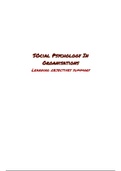SOcial Psychology In
Organisations
Learning objectives summary
, Sofia Cassuti
2021.01.11
Chapter 1
Learning Objectives +Answers
1.1: Define the concept of organizational behavior (OB).
- The study of individuals and their attitudes and behaviors at work.
- Hawthorne effect: when people receive attention they work better (feeling like
receiving special treatment)
1.2: List and give examples of the four sources of information used in evidence-based
management (EBM).
Def: EBM is the ability to translate research to practice.Evidence-based management
improves a leader’s decisions by disciplined application of the most relevant and current
scientific evidence. Although many definitions of evidence-based management are available,
Briner, Denyer and Rousseau (2009) define it as how leaders can be more effective in all
aspects of their jobs including making decisions about employees, teams or organizations
through the conscientious, explicit and judicious use of research information.
The four sources of information are:
1. The best available scientific evidence – Research published on leadership and
management.
2. The best available organizational evidence – interviews and/or surveys from people in
your organization.
3. The best available expert evidence – knowledge from experts in the field.
4. Value-added evidence — Information from stakeholders – for example, stock price to
shareholders or the organization’s promotion of women and minorities into upper
management positions.
1.3: Define critical thinking, and explain the critical thinking skills leaders need.
Def: the objective analysis and evaluation of an issue in order to form a judgment.
The critical thinking skills a leader needs are: Rationality, self awareness, honesty, open
mindedness, discipline, judgement
1.4: Describe the scientific method used in OB research.
Using evidence based management
1
, Sofia Cassuti
2021.01.11
1.5: Discuss five types of outcome variables studied in OrgBeh.
1. Performance
a. OCB: Organizational citizenship behaviour: workers willingness to help others
more than it is requested
2. Work-Related attitudes
a. Organizational commitment: how loyal the person is the the company
b. Employee engagement
3. Employee well being
a. Stress, Psychosomatic symptoms, emotional exhaustion
b. Non engaging/passive leader causes stress
c. Also receiving illegitimate tasks
4. Motivation
a. Intrinsic motivation is also very important
b. Extrinsic is the rewards such as bonuses
c. Motivation as an independent variable because it is that important
5. Employee withdrawal
a. Absenteeism = low levels of job satisfaction
2
, Sofia Cassuti
2021.01.11
1.6: Compare the levels of analysis in OB research.
Level 1: Individual level
Level 2: Dyad: two party level (mentor and protegé)
Level 3: Group and Team level
Level 4: Organizational level
Level 5: Industry level
1.7: Develop plans for using OB research to improve employee job performance.
Motivation has to be present at all levels. Domino effect: they all influence each other.
1.8: Compare and contrast Theory X and Theory Y assumptions.
Theory X: pessimistic view/assumptions (workers are lazy)
Leaders behaviour: controlling, coercion, surveillance, lack of trust, sees participative
decision making as a threat to their power
Theory Y: optimistic assumptions (workers are motivated and good)
Leaders behaviour: discretion, participation, encouragement of creativity, participative
decision making is liked and resulted in higher job satisfaction BUT NO significant impact
on organizational citizenship behaviour and commitment
Chapter 2
2.1: Define personality, and discuss the role of heredity.
Def: regulaties in feeling, thought and action that are characteristics of an individual.
The role of heredity: Occupational choice is 50%
Work motivation: 40% heredity and 60% environment
2.2: Discuss the benefits and limitations of using the Myers-Briggs Type Indicator in
organizations.
It is the most widely used personality test for organizational purposes. It can serve as a
prediction but when taken twice it might wield different results that questions its validity. 16
categories only. It’s a good tool to understand personality differences and that they are all
useful when put in the right position.
2.3: List and explain the five factors in the Big Five theory of personality.
OCEAN: openness, conscientiousness, extraversion, agreeableness, neuroticism
Conscientiousness is the one that was the most important when looking at job performance. It
basically means that you get things done and that is crucial.
3






